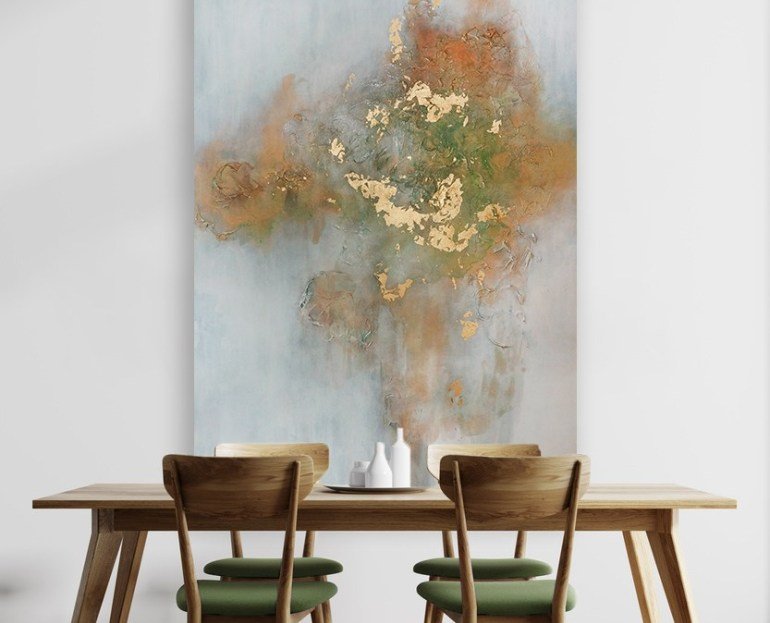What you put on your walls, (or the lack thereof,) says a lot about you and your home. Whether it is a one-of-a-kind original painting, a framed print, or some other piece of wall décor, the size you chose for the space you have can make or break a space. Art can make a room feel larger, grander, smaller, cozier, or in some cases, just plain awkward. Art is a focal point, it’s a key part of décor that changes the mood and energy of a space, it sparks conversation and either finishes and polishes a room, or makes it fall flat.
The biggest problem I find with most art installations is not the quality of the art but rather the size being wrong for the space. If you are DIYing your space, you may find yourself asking “What size is right for my wall?”
Here are 4 things to consider when choosing what size art to put on your walls:
1. The Room – If you are investing in art, you certainly don’t want to buy it, and hang it, only to discover your room still feels barren. Measure your walls and measure out different size pieces to fill your space. I suggest taping up craft paper in the dimensions of the measured space just to get a sense for how much space the art is going to take up. Measuring is different than seeing and feeling the occupation of space. Take into account the kind, size, and quantity of furniture in the room. Do you have shelves that will clash with the hanging height of the piece to make it look awkward? If the if the room is sparse, then a large piece of artwork will fill up the visual field the same way furniture might. Think about your ceilings, are they high? vaulted ceilings? If you have large walls then you have to either go with big art, or something like a gallery wall to fill that visual space. Do you have a low clearance and want your ceilings to seem taller? Just keep in mind that bigger is usually better. I’ve never heard the complaint, “it’s just too big,” but I have heard, “I think the painting is just too small. This is especially true if buying modern, contemporary art, bigger is definitely better to maximize the statement.
2. Orientation of the Art –When considering the wall, you will probably measure it several times, maybe even map it out with craft paper to see how much space it will take up, then what? You need to think about two things here, there is the overall dimensions of the wall, but then you also need to think about the orientation and optical illusions you’d like to employ with the painting. For example, if your ceilings are low and you have a narrow space above your couch, you may be tempted to put a horizontal piece in that space. Consider putting in a vertically oriented piece or a square to draw the eye up and make your ceilings look taller. In looking at the overall wall space, your artwork should take up two-thirds to three-fourths of the wall. The same is true of gallery walls, they should take up the same or even more wall space than one large statement piece should.
3. Hanging over Furniture – Many clients who ask for my help in size recommendations for art for their home send me photos of the wall where they intend to hang the piece. I really appreciate it when I get photos from clients because it really helps be visualize the space and can better assist and advise. The size in relationships between art and furniture is important. For example, a 30” painting looks lost and floating over an 8-foot couch. Here is a good rule of thumb when hanging art over furniture like a couch, table, fireplace, bed, etc.… The art should be at least three-fourths the width of the furniture, if not full width. There should be an equal distance from the ceiling to top of the painting, as there is on the bottom of the painting to the furniture below. Of course it doesn’t need to be exact, and most of the time I’m a huge fan of off center, asymmetrical hanging or foregoing hanging all together to letting a big painting just rest of the floor. It brings wonderful visual interest and a flowing peaceful energy to a space.
4. Price – Usually I find that people choose smaller art it is because of their budget. When a piece is purchased or commissioned solely based on price sometimes it just falls flat in the space because it’s too small. My encouragement is to think about buying art in the same way you would buying a couch or dining room table. It’s a statement. In the same way that you’re willing to invest money on a big couch or table, it is no different with big, custom, handmade original art. In fact, original art is often more valuable than a couch or table, because it’s handmade and one of a kind, unlike a mass-produced couch you’re going to throw out in ten years. If you’re doing your art buying strategically, art goes up in value over time, unlike a couch or table which decrease in value over time. Invest in your art and walls the same way you’d invest in furniture. The art is going to last longer and be more valuable in the future. And if a specific piece is out of your budget ask about a payment plan or save up for the right size piece for your space. Never sacrifice size for price.
I hope you enjoyed this sizing guideline. As always if you ever have any questions regarding sizing for you space, don’t hesitate to ask. If you like this post or learned something new, please share it with your friends, family and followers.
Follow me on Instagram @christineolmstead Pinterest @christineolmstead Facebook @ceolmstead



Comments
If I send you pic of my wall will you suggest what size art piece needs to be? Thanks
Thanks for insight. I. Had been thinking of my budget.